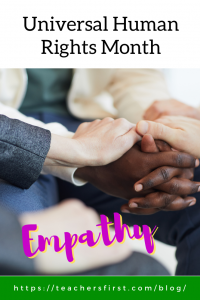“Empathy is intuitive, but is also something you can work on, intellectually.”
Tim Minchin
December is Universal Human Rights Month, a time where people worldwide are encouraged to stand up for fundamental rights and freedoms for all humans, and exercise empathy for others. This month also features Universal Human Rights Day on December 10, the anniversary of the Universal Declaration of Human Rights document written by the United Nations in 1948.

Empathy is broadly defined as the ability to put yourself in another person’s shoes. Some describe empathy as a kind of “social antenna” that promotes curiosity about understanding others, which can be achieved by developing skills that raise awareness of cues provided when interacting with others. Psychologists provide us with an understanding of empathy by discussing five different skills: empathic resonance, perspective taking, cognitive empathy, empathic concern (compassion), and empathetic joy. This YouTube video provides an excellent explanation of these skills.
Teaching empathy goes beyond providing good role models – it also involves direct instruction of the skills needed to become an empathetic person. This interesting article from Psychology Today discusses how medical training diminishes empathy in physicians, a skill that needs revisiting to facilitate patient satisfaction and compliance with treatments.
How do we teach empathy to students? Fortunately, educators have several options to choose from. Here are a few:
Start Empathy Toolkit (reviewed here) – this downloadable booklet is provided by Ashoka, a global network that embraces a “changemaker world.”
- Shares lessons using a roadmap of prepare, engage, reflect, and act.
- Designed for grades K-5; however, there are some items for older students and adults.
- Includes role-play activities, morning meeting suggestions, and afternoon check-ins and exit tickets.
Activities for Teaching the 3 Kinds of Empathy (reviewed here) – created by Samantha du Preez, these lessons are part of The Compassion Project.
- Includes lessons and videos that teach cognitive, emotional, and compassionate empathy divided into age-level categories.
- Part of the Compassion Project Curriculum on Everfi (reviewed here)
Developing Empathy (reviewed here) – The Equality and Human Rights Commission provides this lesson, part of a twelve-lesson unit on human rights.
- Though created for grades 8-12, the contents are easily adaptable for use in grades 5 and older.
- Includes a downloadable lesson plan, PowerPoint slides, and student worksheets that teach empathy through role-playing activities.
Extend learning:
- Ask students to add sticky notes to a Google Jamboard (reviewed here) that shares ways to show empathy. Try it by adding your ideas on teaching empathy to this Jamboard. Find more ideas on how to use Jamboard by watching the archive of the July 2020 OK2Ask session, “Jamboard for Authentic Learning Activities”.
- Create a class or individual word clouds using the WordCloud Generator (reviewed here) that includes words that demonstrate or describe empathy.
- Share your stories of demonstrating empathy with others by creating trading cards using the Trading Card Maker from Big Huge Labs (reviewed here). Take pictures of students and staff demonstrating empathy in different ways, such as active listening, helping others, or showing joy for others’ accomplishments.
Developing empathy for others isn’t something to be studied just for a month, but Human Rights Month is the perfect opportunity to look at options for teaching empathy to our students (and working on our empathy skills).
How do you go beyond modeling to teach empathy? What suggestions do you have for other educators? We always enjoy hearing advice from our readers in the comments!


Love this! Thank you for sharing!